Relation to me: 20th Great Grandfather
William was also known as “le Hardi” (the bold), or the Hardy. He was Lord of Douglas and a Scottish nobleman and warlord.
He was the son of William “Longleg”, Lord of Douglas and possibly his second wife, Constance Battail of Fawdon. William is first recorded at an Assize at Newcastle-upon-Tyne in 1256. An Assize was a periodic court that was held around England and Wales until 1972. It exercised both civil and criminal jurisdiction, but most of their work was on the criminal side. He had appeared in the record when his father made over a Carucate of land at Warndon, in Northumberland to him. His father was Lord of Fawdon, and had, as his superior, Gilbert de Umfraville, the Earl of Angus. He was acquitted of withholding rents by a jury. Umfraville, notwithstanding, attacked Fawdon, imprisoned Longleg at Harbottle Castle and made off with one hundred pounds sterling of goods. William was injured in the fight, nearly losing his head.
The Eighth Crusade
Sir William Fraser puts a theory on the table that David Hume of Godscroft is mistaken about the William Douglas that went on the 8th Crusade. He suggests that it is our William Douglas, the son rather than the father, who had accompanied David I Strathbogie, Earl of Atholl, and other Scots nobility on the 8th Crusade in 1270. As is recorded by John of Fordun in his “Chronica Gentis Scotorum“. Fraser also concedes that there’s no evidence that still exists to verify this, except referencing Godscroft’s work.
Lord of Douglas
William’s father, William Longleg, died at some point in about 1274, and there’s a bit of confusion as to whether his eldest son, Hugh, predeceased him. However, William the Hardy was certainly in possession of his estates by the end of the decade.
Our William, was knighted before 1288, when he was called upon by Sir Andrew Moray to imprison his uncle, Sir Hugh Abernethy at Douglas Castle. Abernethy had been a party to
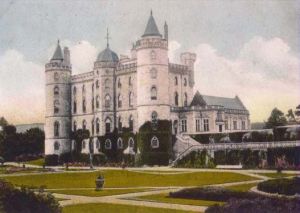
Depiction of what Douglas Castle may have looked like. Actual castle was destroyed by fire in 1755.
the murder of Donnchadh III, Earl of Fife, one of the six guardians of Scotland. While in custody, Abernethy died despite attempts by Edward I of England to have him released.
In 1289, William requested the release of certain family charters from Richard, the Abbot of Kelso. These charters had been kept at the Priory of Lesmahagow, a daughter house of Tironensian of Kelso, for safety. Upon receiving these documents, William styled himself Dominus de Duglas, Lord of Douglas. This was the first time that the title had been recorded.
Marriages
William first married Elizabeth Stewart, she was the daughter of Alexander Stewart, the 4th High Steward of Scotland. With her, he had his eldest son James. Elizabeth appears to have died before the end of 1288, possibly in childbirth.
He then married Eleanor de Louvaine, later in 1288. William and a Borders Knight known as John Wishart had surrounded the Castle of Fa’side near Tranent. The castle was held by Alan la Zouche, the 1st Baron la Zouche of Ashby and feudal superior of the barony of Tranent. Within the castle was Zouche’s wife Eleanor, and another Eleanor, the recently widowed wife of William de Ferrers of Groby, the second son of William de Ferrers, the 5th Earl of Derby. Eleanor was the daughter of Matthew de Louvaine, a great grandson himself of Godfrey III, Count of Louvaine. King Edward had provided a handsome dowry from her husband’s England lands following his death. William Ferrers also possessed lands in five counties in Scotland, and Eleanor had come north to collect her rents. Rather than desolate the land and the castle, William contented himself with abducting Eleanor and removing her to Douglas Castle.
Eleanor, was apparently not averse to the rough charms of her kidnapper, and William Douglas were married not long afterwards. King Edward was not so charmed, and ordered the Sheriff of Northumberland to seize all of Douglas’ possessions in that county and to apprehend William and Wishart if the chance arose. He also demanded that the Guardians of Scotland immediately arrest William and deliver him and Eleanor to his pleasure. The Scottish Guardians would not respond. William was connected to two of the Guardians: James Stewart, the 5th High Steward of Scotland, was his brother-in-law and Alexander Comyn, the Earl of Buchan, was a brother-in-law of Eleanor de Louvaine. The guardians may not have reacted well to the peremptory nature of the English king’s request either.
William Is Imprisoned for the First Time
William seems to have fallen into the hands of the English monarch in the early part of 1290 and was confined at Knaresborough Castle. This imprisonment does not appear to have been unduly harsh. He was released by the spring of 1290, when his wife Eleanor posted bail for his release with four manucaptors in May of 1290.
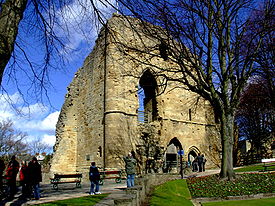
Knaresborough Castle Ruins
These four knights, all being her cousins, were John Hastings, the 1st Baron Hastings, Nicholas de Segrave, the 1st Baron Segrave, William de Rye and Robert Bardulf. William was in favor again and he and Wishart had their Northumbrian lands were restored. Eleanor would be fined one hundred pounds sterling, and by way of payment had some of her manors in Essex and Herefordshire taken by the crown in 1296.
Build up to War
His seal is on the Treaty of Salisbury approving the putative marriage between Margaret, the Maid of Norway, with Edward of Caernarfon. It was among these nobles that hammered out the deal that would become the Treaty of Birgham. At Norham in June of 1291, the Guardians accepted King Edward as Lord Paramount of Scotland. While the negotiations were progressing, regarding the choice the choice of the next King of Scots. Edward was staying with Sir Walter de Lindsay at Thurston Manor, near Innerwick, when William Douglas paid an oath of fealty to him in the chapel there.
By the end of 1291, William had a falling out with King Edward again and had his lands of Douglasdale forfeited to the English king. Edward appointed his own creatures as baronial
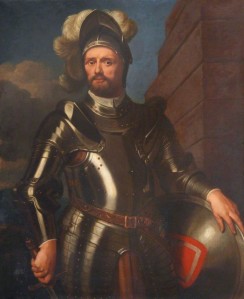
John Balliol painting (c) Bodleian Libraries; Supplied by The Public Catalogue Foundation
officers and made Master Eustace de Bikerton, Parson of St. Bride’s Kirk, the spiritual home and burying ground of the Douglas’. John Balliol was declared King of Scots on the 17th of November of 1292 and called his first parliament on the 10th of February 1293. William, along with Robert de Brus, Earl of Carrick, Alexander, Lord of Islay, John, Earl of Cathness failed to attend and were proclaimed defaulters. William attended the second parliament of King John, but was imprisoned again, this time at Douglas Castle, for failing to comply with royal officers enforcing a judgment against him. While he was in prison, William was duty bound to be at his lands in Essex, in order to provide service for Edward, his failure cost him twenty pounds of stirling in fines.
The Siege of Berwick
Upset at the humiliations heaped upon John Balliol, and the ineffectiveness of his rule, a new Guardianship was created in 1295. These men concluded a treaty at Paris and ratified it at Dunfermline between the Kingdoms of Scotland, France and Norway, that would become known as the Auld Alliance.
Siding with his countrymen, William was appointed as Governor of Berwick upon Tweed, the most important commercial center in Scotland at the time. When the Guardians threw down the Gauntlet to Edward, he arrived at the walls of Berwick with 5,000 Cavalry and 30,000 Infantry. Following this was one of the most brutal episodes in British history, the Sack of Berwick.
The English army took the town by storm on Good Friday of 1296 and gave no quarter to the inhabitants. The slaughter lasted for two days and the estimated death toll was between 7,500 and 8,500 men, women, and children. Appalled and after a resolute defense, the garrison of Berwick Castle under the leadership of William Douglas, gave themselves up to the mercy of King Edward. The garrison was freed and were allowed to march out of the castle with their arms, but William was imprisoned and the last of his estates in Essex were forfeited. William’s two year old son, Hugh, was taken into the ward by the Sheriff of Essex at Stebbing, one of the forfeited properties.
Ragman Roll
William was imprisoned in Hog’s Tower at Berwick Castle and stayed there until he gained his freedom by appending his seal to the Ragman Roll, in common with the majority of the Scots nobility. Within days of his swearing his new oath of Fealty to Edward, William was restored to his lands in Scotland, but not those in England. To add salt to the wound, William’s land at Fawdon and others in Northumberland were given over to his old foe Gilbert de Umfraville, the Earl of Angus. William had no reluctance in joining the patriotic party. Umfraville’s latterly forfeited Earldom of Angus was granted in 1389 to his great grandson, George Douglas, the 1st Earl of Angus.
The Uprising of William Wallace
After the Battle of Dunbar, a large section of the Scots nobility were languishing in prison in England. The countryside was fomenting and there was talks of a new champion for the Scottish people, William Wallace of Elderslie had started his campaign.
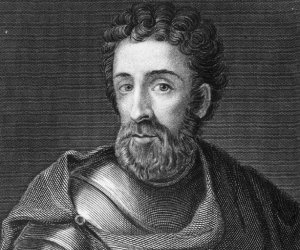
William Wallace
William Douglas was summoned to attend King Edward in London on July 7th 1297, with fifty other barons to accompany him on an expedition to Flanders to aid Guy of Dampierre, Count of Flanders against Philip le Bel, the King of France. William refused and joined the company of Wallace instead. Most of the Scots magnates thought that Wallace was beneath their dignity, but William Douglas had no such compunction. He was the first nobleman to join Wallace in his 1297 rebellion. The two combined forces at Sanquhar, Durisdeer and later Scone Abbey where, together, they liberated the English treasury. With the booty, Wallace financed his further rebellion.
Wallace joined forces with that of Sir Andrew Moray and together they led the patriot army in the Battle at Stirling Bridge, fought on September 11th of 1297. They were joined by other patriots, such as Robert Wishart, the Bishop of Glasgow, and the Morays of Bothwell, with a contingent of Douglas’ at the national muster at Irvine in North Ayrshire.
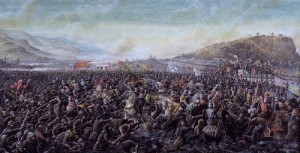
Battle of Stirling Bridge
Bruce’s Raid on Douglas Castle
When Edward heard of William’s supposed treason, he commanded the future King of Scots, Robert Bruce, the Earl of Carrick, then governor of Carlisle for the English to take retribution. Bruce swept into Douglasdale at the king’s orders. However, young Bruce, was only twenty-two years old at the time stated:

Depiction of Robert Bruce
“I must join my own people and the nation I was born”.
He then was joined by the men of Douglas and Lady Douglas, prior to joining the rebels at Irvine.
Capitulation of Irvine
The third time that William Douglas was held prisoner of Edward Plantagenet, was after July 9th of 1297, when he was accused by Sir Henry de Percy of breaking his covenant of peace with Edward that was agreed to in the document known as the Capitulation of Irving Water. William was in the company of Robert Bruce, Alexander de Lindsay and John and James, the latter three his brothers-in-law, when Sir Andrew de Moray and William Wallace won their great victory at Stirling. Sir William the Hardy was again Edward’s prisoner at Berwick Castle, staying in what is now called ‘Douglas Tower’.
William’s Death
After Wallace’s success at Stirling Bridge, the English fled Berwick on Tweed with William Douglas and another Scottish prisoner, Thomas de Morham. Both later were committed to the Tower of London on the 12th of October 1297. William would meet his demise at the Tower in 1298 due to mistreatment.

The Tower of London. Photo taken by Christina Siceloff 2010
Another wonderful post of another shared ancestor. (William “le Hardi” Douglas is my 21st great-grandfather.)
LikeLiked by 1 person
Hi, my name is Mike Lewis from Austin, TX. My dad’s mother was Nora Vivian Hardy, and I’ve worked her line back to at least the 1400’s on Ancestry.com, but do you have any recommendations on tips to verify this line? Thanks to all my cousins who have already figured this stuff out. I was raised being taught that my direct line went back to the Knight le hardi who fought 950 years ago today at Hastings.
LikeLiked by 1 person